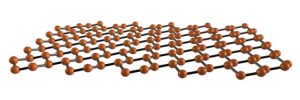
Researchers have created the first transistor out of silicene, the world’s thinnest silicon material.
Image: University of Texas at Austin
There’s an exciting new development in the world of single-atom thick materials, and surprisingly it doesn’t revolve around graphene.
Instead, scientist have shifted their attention to silicene: an exotic form of silicon that has fantastic electrical properties for computer chips.
Like graphene, silicene is a single-atom thick material that allows electrons to flow through it at amazingly high speeds. However, silicene does not occur naturally like graphene – it instead has to be grown in the lab on a sheet of silver.
Because of the difficulty encountered when attempting to produce silicene, its properties have only been theoretical until now. Recently, Deji Akinwande of the University of Texas at Austin turned his attention to this material and found a way to make a transistor out of silicene.
This from MIT Technology Review:
Once silicene is made, its instability means it must be protected, and that makes it difficult to work with. Akinwande found a way around this problem by growing silicene on a thin film of silver capped with aluminum oxide. The whole thing is then peeled off, and then placed on a silicon dioxide wafer with the silver side up. Finally, the silver is patterned to make the electrical contacts for a transistor. Once the device is finished, it is stable under vacuum conditions.
While silicene yields a lot of promise for the future of computers, it is unlikely that you’ll get your hands on a device using the material any time soon. The material’s amazing properties have been confirmed, yet scientists still face the issue of the expense and difficulty when producing silicene.
To learn more about silicene, head over to the Digital Libary to read our most recently published papers on the new “wonder material.”
[Source: Gizmodo]

